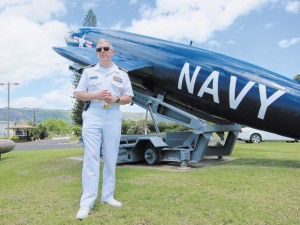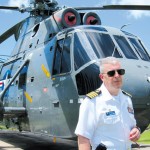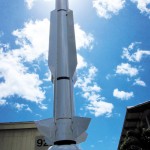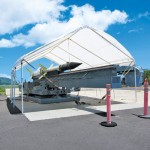Missile Man

With North Korea capable of striking Hawaii, PMRF’s missile defense program is of utmost importance. Meet the man in charge, Capt. Bruce Hay. Coco Zickos photo
Drunken aliens leaving zigzag contrails over Hawaii is just one of the many stories Capt. Bruce Hay has debunked during his term at Pacific Missile Range Facility (PMRF). The evening after missiles were launched in May, their trails lingered in the sky as the sun set, causing many to speculate we were being visited by galactic intelligent life.
“That didn’t help our case,” says Hay, who is taking great strides to demystify the base, such as inviting Kauai Midweek to tour the grounds.
PMRF, a Navy testing and training facility located at Barking Sands on the Westside of the island, has been largely inaccessible to the public (unless a special pass is acquired) since Sept. 11, 2001. But Hay ensures there is nothing unusual occurring at the Navy headquarters.
“Kauai has a diverse crowd of people interested in a lot of different things, so we hear a lot of differing opinions on things that may or may not happen out here,” says Hay, who serves as commanding officer.
The more than 2,000 acres of land at the base resembles a small town with its own fire department, airport, mini mart, barber shop and even a Subway restaurant, as well as the only racquetball court on the island. While the base employs about 1,000 people (85 are active-duty military like Hay; 150 are government civilians and the rest are contracted civilians), only some 150 live on base, including Hay.
“We’re just like the rest of Kauai,” says the New York native.
- Capt. Bruce Hay is PMRF commanding officer
- One of the ‘alien’ missiles
- PMRF serves as a testing and training ground for the Navy
But the rest of Kauai doesn’t contain rocketor missile-launching facilities, nor does it house low-density supersonic decelerators. PMRF’s mission focuses on defensive weapon systems and is the “world’s largest instrumented multi-environmental range of supported surface, subsurface, air and space operations simultaneously,” according to its website. In addition to its land, PMRF covers more than 1,000 square miles underwater, and more than 42,000 square miles of air.
PMRF also is the only place on the Garden Isle where an Aegis Ashore Missile Defense Test Complex (aka “mission control”) is stationed. The complex resembles a Navy ship and serves as a testing facility for protecting, tracking and engaging missile targets. The difference between the facility and a ship is that only 12 active-duty sailors and a handful of contractors operate the combat system, as opposed to the hundreds who would be required on a vessel. In addition, the building cost around $60 million, plus another $7 billion for radars and other specialized equipment. While this is a tremendous cost to taxpayers, a ship would have created a price tag triple this amount.
“It makes enormous sense fiscally,” explains Hay, who adds that no Navy ships are docked at PMRF (they remain on Oahu). “Although those numbers may not sound like they make sense, it really is a lot of bang for your buck.”
The base serves as a missile assembly center, though it is also a “popular misconception” that warfare is stored at the headquarters.
“We don’t keep a stock-pile of stuff waiting to shoot,” says Hay. “If you look at commercial logistics, that’s money that’s trapped up in inventory that could be doing something else.”
The U.S. Navy has come a long way from its initial days of Regulus missile testing at the base in the 1950s. The land initially was acquired in the 1920s by Kekaha Sugar Company, where the island’s first airport was established. World War II brought the U.S. Army Air Force to the area, and by the 1960s, the land was transferred to the Navy.
Hay enjoys the fact that he has such an impact on modern-day training and tactics. He received his commission through the Reserve Officer Training Corps at Union College, and earned a degree in industrial economics. Then he reported to NAS Pensacola for flight training, and he became a naval flight officer by 1992. He still gets to fly planes and likes traveling on boats to do security perimeter work with the “kids.”
“Although you wouldn’t know it by my tan, I’m actually outside quite a bit,” jokes Hay.
He has been grateful for the year he already has spent on the island since accepting his position.
“It’s flown by — I’m already dreading having to leave,” says Hay, who has about two more years to complete his tour at PMRF. “People are so unbelievably nice here.”
He lives in a home on Barking Sands Beach with a view of Niihau in the background that would make anyone envious.
“If you can’t solve whatever’s ailing you by sitting out here watching the sunset with a beverage of your choice, then it’s time to hang it up,” he says.
He’s even named the jungle fowl that routinely visit him, calling them “my chickens.”
“I didn’t know that when you feed chickens, they call every chicken within a 400-square-mile radius,” he jokes, pointing out Midnight, Shadow and Pierre, aptly named for the floppy comb on his head that looks like a barrette.
Though he finds time to delight in these small moments of his life now, his service in the Navy wasn’t always so easy, especially during his 10-month deployment on the historic USS Abraham Lincoln for Operation Iraqi Freedom.
“It’s a long, long time to be away from home,” says Hay, who is married to his high school sweetheart, Susie.
But it is a life he willingly signed up for and has yet to regret. He looks forward to his next assignment.
cocomidweek@gmail.com






